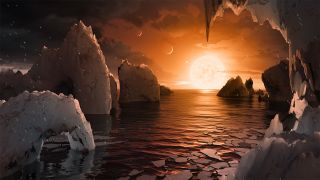Meet the 7 exoplanets of TRAPPIST-1
:: The Watch Tower :: Satellite V
Page 1 of 1
 Meet the 7 exoplanets of TRAPPIST-1
Meet the 7 exoplanets of TRAPPIST-1
James Webb Space Telescope meets the 7 intriguing exoplanets of TRAPPIST-1
*By Jamie Carter
*The imagined surface of the exoplanet TRAPPIST-1f. (Image credit: NASA/JPL-Caltech)
When will astronomers unveil the truth about the seven planets in 'solar system 2.0'?
Go outside tonight and look at Jupiter shining brightly in the south. Now look just to its right side and go 235 trillion miles (378 trillion kilometers) into the cosmos. Here between the head of Pisces and the side of Aquarius is a nondescript star called TRAPPIST-1, an ultra-cool red dwarf discovered in 1999.
TRAPPIST-1 was mostly forgotten until 2017, when NASA announced that it hosted the most Earth-sized planets found in the habitable zone of a single star to date. Exoplanet-hunters have been obsessed with TRAPPIST-1 ever since. At last count, the neighborhood held seven planets, nearly matching the eight found in our own solar system. But is TRAPPIST-1 a mirror or a mirage? Could it contain Earth-like planets — and possibly life — or does its passing resemblance to the solar system hide alien planets with inhospitable conditions?TRAPPIST-1: a solar system 2.0?
And astronomers have spent that time learning as much as possible about the seven TRAPPIST-1 worlds. In 2018, a study suggested its planets were rocky and that some could be wetter than Earth. In 2021 another study argued that they were likely rocky, although less dense than the planets in our solar system.
The TRAPPIST-1 system likely isn't much like the solar system. Although four of the seven planets occupy the star's habitable zone — close enough to be warm enough to host liquid water — all orbit their star closer than Mercury does the sun.
Given that the star is much dimmer than our sun, that may not affect temperatures too much, but it drastically affects the conditions on the planets. For example, the closest planet, TRAPPIST-1b, orbits its star in 1.9 Earth days. That's a very short year. On TRAPPIST-1h, the farthest, a year takes just shy of 19 days. What's more, all of the planets are likely tidally locked, much like the moon is to Earth, so only one side ever gets daylight.
Despite these differences, TRAPPIST-1 remains the top exoplanet target for JWST because of its diversity of rocky planets. And although it's one of the most-studied planetary systems, scientists still think TRAPPIST-1 has a lot more secrets to reveal.
TRAPPIST-1 the only star system we know with seven potentially Earth-like planets, but it's far from being the closest planetary system. That honor goes to Proxima Centauri, at 4.24 light-years away from Earth.
So why the fascination with TRAPPIST-1, which is 10 times farther? "Proxima does not transit and it's transiting exoplanets that we need," Lisa Kaltenegger, an astronomer at Cornell University, told Space.com. Our line of sight to the TRAPPIST-1 system is perfect, and our telescopes can see its seven planets crossing the disk of the star.
"The closest transiting planets give us the most looping signal, which is why TRAPPIST-1 is one of our favorite systems," Kaltenegger said. Astronomers can watch the TRAPPIST-1 planets go round and round.
Last week astronomers finally got a glimpse of JWST's first look at the TRAPPIST-1 system.
It's not yet been peer-reviewed or published, but at a conference at JWST's HQ — the Space Telescope Science Institute in Baltimore — on Dec. 13, scientists discussed the telescope's initial data from its observations of TRAPPIST-1g, the second-farthest planet from the star.
Björn Benneke, an astronomer at the University of Montreal in Canada, showed that TRAPPIST-1g doesn't have a hydrogen-rich atmosphere. Olivia Lim, a Ph.D. student at the University of Montreal, also presented a poster with similar results for TRAPPIST-1b (part of a reconnaissance program of all TRAPPIST-1 planets) as did Alexander Rathcke, an astronomer at the Harvard Smithsonian Center for Astrophysics, for observations of TRAPPIST-1c.
Lewis will study TRAPPIST-1e. "It's the one in the middle of the habitable zone that's closest to the size of Earth," she said.
Remember, this research is just about the planets' atmospheres. "We don't get to start asking about aliens probably for a few cycles!" Lewis said.
But exoplanet science is not done in isolation. Lewis is working with the University of Montreal because their observations of TRAPPIST-1d and TRAPPIST-1f — two of the other planets in the habitable zone — will together make for a fascinating comparative sample.
"Having Venus, Earth and Mars in our own solar system has really informed us a lot about why Earth is habitable, about global warming and what could happen if Earth was slightly smaller," Lewis said.
One of the TRAPPIST-1 planets will go down in history as hosting the first detected atmosphere of an Earth-size planet beyond our solar system. The next few months, years and decades will see the TRAPPIST-1 system gradually revealed in exquisite detail. But as well as finding out the true nature of its seven Earth-size planets, expect to see the neighborhood used to conduct some fundamental exoplanet science.
Read the full article at: https://www.space.com/james-webb-space-telescope-trappist-planets

Bad Wolf- Designer GFX

-


Level : 46
Number of posts : 3391
Location : Satellite V
Rank : 7
Experience : 3014
Registration Date : 2006-12-24
Cprofile
Title: The Digital Alchemist
Luck:


 (588/588)
(588/588)
Karma:


 (530/777)
(530/777) -

:: The Watch Tower :: Satellite V
Page 1 of 1
Permissions in this forum:
You cannot reply to topics in this forum



